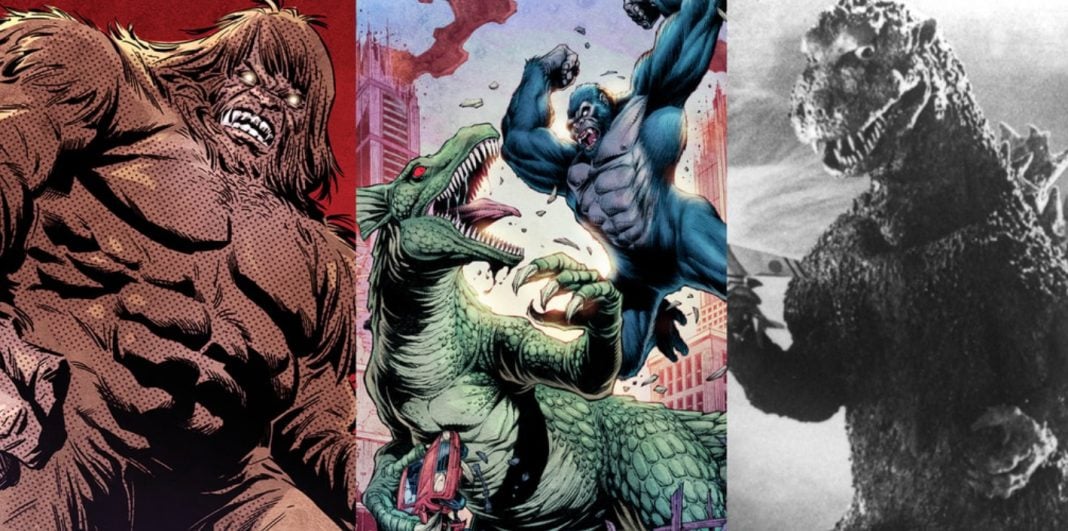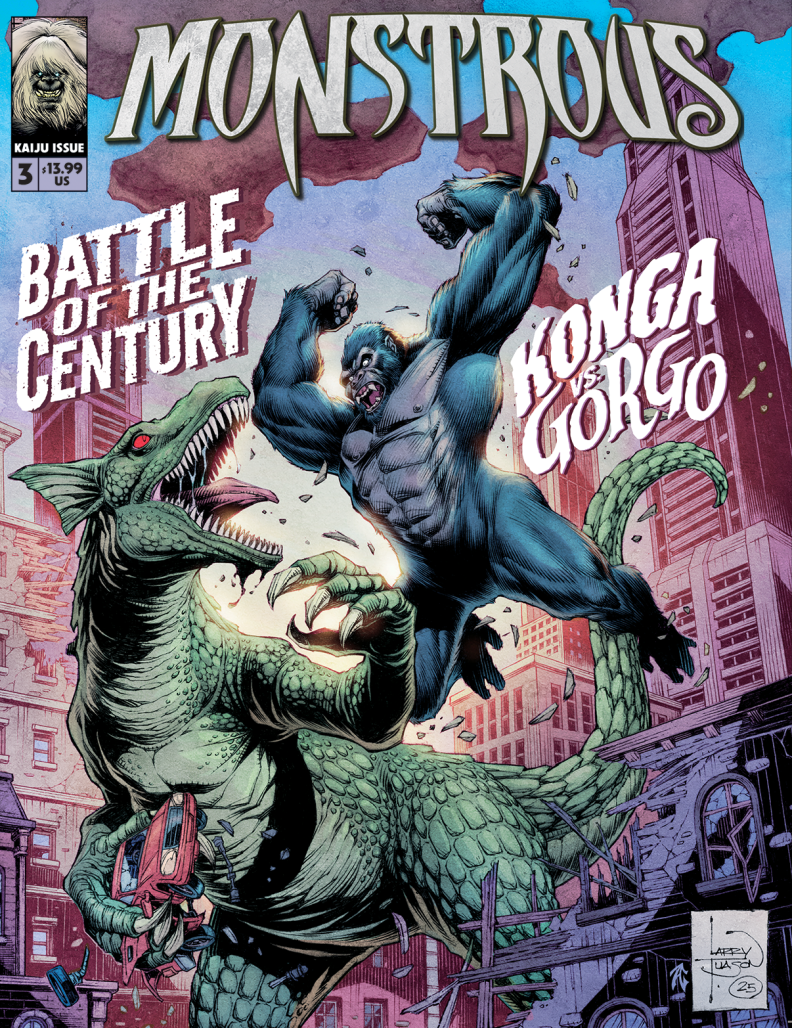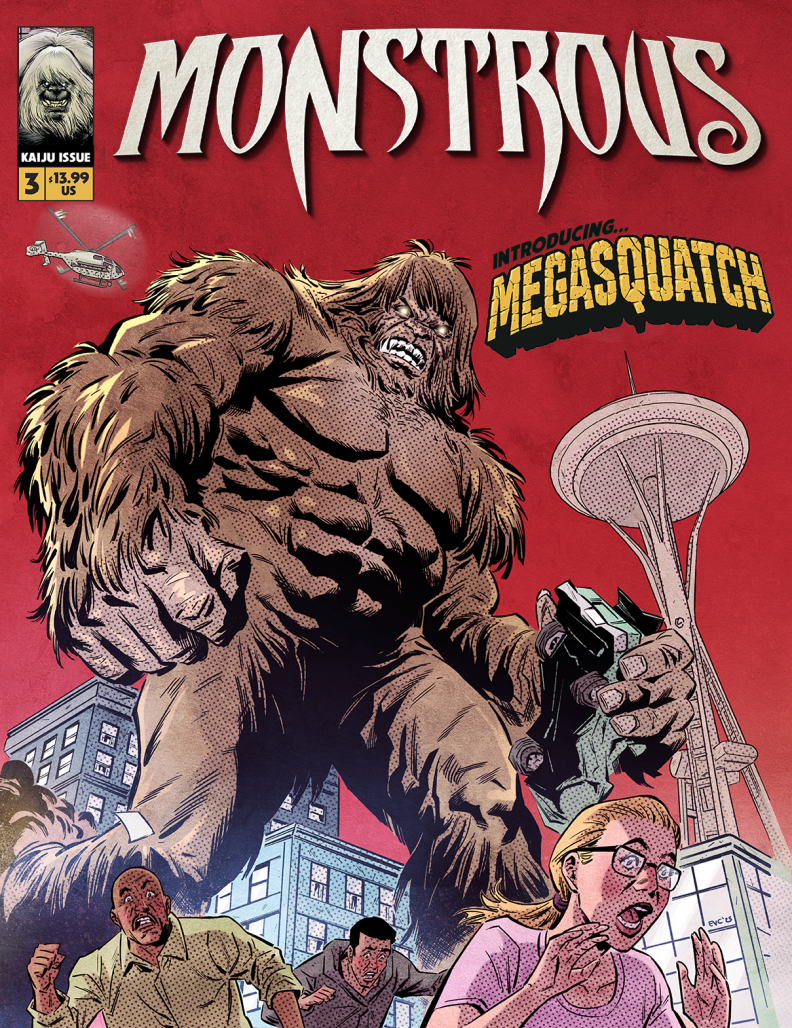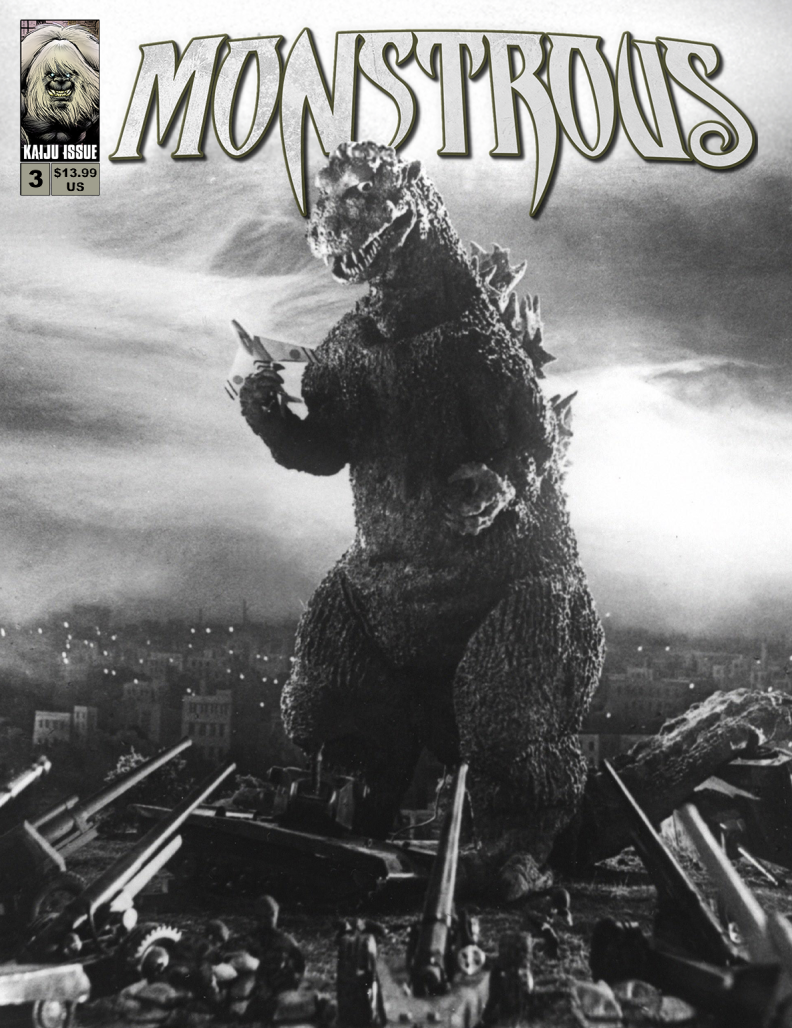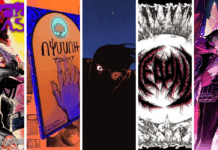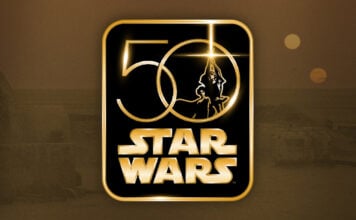Whether it’s Godzilla or his various brethren, it’s no exaggeration to say that there’s been a resurgence in the popularity of Kaiju over the last few years. Thus it’s fitting that for the latest issue of Monstrous Magazine, publisher Monster Magazine is going big with Monstrous: The Kaiju Issue, oversized issue celebrating legendary monsters launching on Kickstarter.
The issue will include a variety of features including an essay on the history of Kaiju toys from Ninjago writer and Wandering Planet Toys co-founder Chris “Doc” Wyatt. The Beat is proud to exclusively publish Wyatt’s piece “Terror in Plastic” for the Kaiju Issue of Monstrous Magazine.
TERROR IN PLASTIC
A short history of Kaiju Sofubi toys
By Chris “Doc” Wyatt
Every time Danny Elfman hits Tokyo he has a mental list of toy shops he’s going to raid.
Danny’s an international mega-star musician because of his work on Tim Burton movies (that Batman theme, oh my god), on Sam Rami movies (that Spider-Man theme, oh my god), and on The Simpsons (that Simpsons theme, oh my god), and for the legacy of his quirky-as-hell ’80s new wave goth party band, Oingo Boingo (“Deadman’s Party,” oh my god). His theme for Netflix’s Wednesday has helped that show become, at the time of this writing, the number one streamed show globally.
Danny has an obsessive fan following; but Danny, in turn, is an obsessive fan himself. A fan of vintage toys, especially SOFUBI. So, he stalks through the tiny back alleys of Tokyo to find rare treasures to add to his ever-growing collection. Places like T-Base, in Shibuya, that sells small batch runs of vinyl toys by indie artists. Or Mandrake CoCoo in Akihabara, a vast space that feels like a sofubi museum. Or Gaocchi in Nankano Broadway, a tiny, packed shop so dense with vintage, original wave sofubi that a collector could easily spend hours toy hunting.
Danny Elfman isn’t alone. The American sofubi collecting market has exploded in the last decade—with dozens of online resellers and endless handcrafted offerings from indie artists. But even with this expansion, it still feels like a niche, highly specialized sub-section of toy collecting. To really steep yourself in the culture, you’ve got to make an effort.
Wait—back up… What exactly are Sofubi? The term is a portmanteau taken from the Japanese words for “soft vinyl” (sofuto biniru). Sofubi are just hollow, vinyl toys. But when we use the term in English, we’re usually referring to vinyl toys from Japan, based on Japanese pop cultural icons (Kaiju or Sentai characters) or, alternatively, to indie art toys that imitate the Japanese style.
It’s like the word “anime.” In Japanese “anime” refers to “animation” in general. But in English “anime” specifically indicates Japanese animation (or global animation that imitates the Japanese style). Same thing with “Sofubi.”
And without Eiji Tsuburaya, the father of Kaiju, the entire sofubi market wouldn’t exist. To many Tsuburaya, a legendary Japanese filmmaker and special effects artist, was more god than mortal. Creator of Godzilla, creator of Ultraman, Tsuburaya was both a creative genius and a technical wizard. He pioneered special effect approaches that still influence the blockbusters of today.
By the mid-1960s, Tsuburaya had already contributed his magic touch to MANY feature films, but he was looking to crack television as well. Tsuburaya had an idea for a horror anthology series which he initially wanted to call Horror Theater Unbalance or alternatively just Unbalance. He envisioned it as a “monster of the week” style show in the vein of Twilight Zone or The Outer Limits but with a Japanese twist.
That idea eventually creatively evolved into Ultra Q. The show was a sort of ’60s Kaiju X-Files, following a fringe team of paranormal investigators, investigating everything supernatural, including ghosts and aliens. The show’s network, Tokyo Broadcasting System (TBS), soon insisted on more giant monsters, because testing showed that kid viewers responded to those episodes the best—so Tsuburaya leaned into the genre he invented: Kaiju. The show was an instant, and MASSIVE hit.
Coming out in 1966, the same year that Tsuburaya’s seventh Godzilla film, Godzilla, Ebriah, Mothra: Big Duel in the South Seas (released in the USA as Ebriah: Horror of the Deep), was tearing through theaters, Ultra Q was largely responsible for the mid-’60s “Kaiju Boom” (a period of intense popular fan and marketing interest in kaiju).
(SIDE NOTE: The Japanese “Kaiju Boom” was happening at almost the exact same time that “Dalekmania” was hitting the UK—a good era for being obsessed with monsters…and toys of them!)
But what does all this have to do with Sofubi? …It was around this time that toy maker Haruyasu Ishida was looking for something. In the 1930s Ishida’s father had been a toy manufacturer, but his father’s company was a casualty of World War II. Only two years after the end of the war, Ishida decided to start again. His new toy company, Marusan, was a way for his whole family to pick up the pieces and move forward.
Founded by Ishida, his brother Minoru Ishida, and their brother-in-law Yasuo Arai, Marusan were initially successful retailing tin toys out of a shop in Tokyo, but by the ’60s they were crowded by competition. They needed something fresh. Something new. Something now. That’s when they saw Tsuburaya’s Ultra Q.
Ishida thought: If kids loved giant monsters on their TV set, why wouldn’t they love them in the toy shops?
Plus, making Kaiju was a perfect way to explore the idea of making toys out of a new material—vinyl. From the early 1900s, dolls and other toys had been manufactured in Japan with a material called celluloid (the same material used for the film that projected in movie theaters).
As opposed to tin, celluloid could create a more life-like skin for dolls, and celluloid was better than other common toy-making materials. It was lighter than wood, and more durable than wax, which would easily chip or break. However, celluloid had one very big draw back. It was HIGHLY flammable… as in, practically explosive! Which was, even in the loosely regulated ’60s, not considered an ideal property for children’s products.
Vinyl however, was derived from the more stable chemical called “polyvinyl chloride” (PVC for short). A synthetic material, PVC was invented by German chemist Eugen Baumann, and perfected by Waldo Semon, an industrial and materials scientist for BF Goodrich. By 1948, vinyl was used to create gramophone music records that were much harder to scratch or break than the early records made of shellac (a natural resin material).
But with his shop in Tokyo, Ishida saw a future in vinyl toys. The low melting point of vinyl and its high degree of plasticity made it perfect for manufacturing figures, and the fact that it couldn’t turn into an accidental Molotov cocktail (the way celluloid dolls could) would be a big selling point to parents. And so, sofubi were born.
The first sofubi to hit the market was—you guessed it—GODZILLA. It was released in 1966, the same year as Ultra Q. Soon followed many of the creatures and characters from Ultra Q and the Godzilla films. Soon the TV ratings success of Ultra Q launched the Ultraman TV franchise with shows like Ultraman, Ultraseven, Ultraman Ace, Ultraman Taro, and literally dozens of others—all of which were translated into tens of thousands of soft vinyl monsters in the hands of kids and collectors.
Though it has a six-decade-long history, the sofubi market has never been larger that it is today (by volume, if not by market share). Prominent Japanese sofubi manufacturers right now include Bandai, Medicom Toy, and Bullmark. But perhaps the most exciting part of the marketplace are the indie artists handcrafting limited-run figures and selling them by “claim sales” in the comments of their social media accounts, or supplying neighborhood stores like Monster Patrol in LA’s Little Tokyo, or Tokyo Toy in New York City.
The quaint, low complexity, retro feel of vinyl toys might make them feel like a blast from the past, but if still growing fan interest is any indication, silicon molds are going to be pumping out vinyl toys for the next 60 years and beyond.
Bram Stoker Award-winning editor and writer James Aquilone’s Monstrous Books has celebrated the traditions of pulp fiction and classic movie monsters with MONSTROUS MAGAZINE, an acclaimed black-and-white magazine-format comic book anthology which features some of the most interesting and inventive genre writers being published today. Now MONSTROUS MAGAZINE will look east for the inspiration for its next all-star anthology: MONSTROUS: THE KAIJU ISSUE will celebrate the legendary monsters from Japan, just in time for the ongoing global celebration of Godzilla’s 70th anniversary. The pre-launch page for MONSTROUS: THE KAIJU ISSUE is now live and readers can click on it to get an email when the crowdfunding project launches.
MONSTROUS: THE KAIJU ISSUE features a fantastic line-up including:
-
-
Ninjago writer and the co-founder of Wandering Planet Toys, Chris “Doc” Wyatt explores the long history of Godzilla toys.
-
“The Colossus From the Crater,” a brand-new sci-fi short story set on a remote moon and featuring a giant alien mummy, penned by novelist Greg Cox, who wrote the official prose adaptation of Godzilla (2014), soon to be reprinted in a new omnibus edition.
-
An all-new Konga vs. Gorgo comic, featuring the creatures from the cult 1960s American International Pictures movies and Charlton Comics, written by James Aquilone and illustrated by Dave Swartz (Confederate Monster)
-
The first appearance of the Kaiju MegaSquatch, in a comic book story by James Aquilone and EV Cantada (Joe Ledger, Grimm Fairy Tales)
-
Three iconic covers — a Konga vs. Gorgo cover by Larry Tuason (Knightingail: The Legend Begins), a MegaSquatch cover by EV Cantada and colorist Zac Atkinson and a Godzilla cover.
-
Just like the creatures themselves, this magazine (previously digest size) will be enlarged to a full-size 8.5-x-11-inch format. “When I decided to do a Kaiju issue of MONSTROUS MAGAZINE I couldn’t pass up the opportunity to do a Kaiju-size magazine, so we’re going from 5.5 x 8.5 to 8.5 x 11 inches,” said James Aquilone. “And that’s just the beginning. We’re resizing the MONSTROUS MAGAZINE back issues, too, and now, for a limited time, they will be available in the new collectible, oversized Kaiju format.”
Previous issues of MONSTROUS MAGAZINE, feature a mix of comics, prose stories, and articles. The debut issue includes:
-
-
A collectible cover by Colton Worley (Kolchak: The Night Stalker 50th Anniversary Graphic Novel, The Shadow)
-
An essay by Elvira Mistress of the Dark writer David Avallone about the legacy of his father, pulp legend Michael Avallone
-
A reprint of pulp legend Michael Avallone’s first short story “The Man Who Walked on Air, ” originally published in Weird Tales in 1953
-
The very first Dead Jack comic, “Dead Jack and Oswald Meet Frankenstein,” written by James Aquilone and illustrated by J.K. Woodward
-
“Monster Rally,” a comic story by Nancy A. Collins with art by Zac Atkinson
-
Other rewards for the MONSTROUS: THE KAIJU ISSUE campaign include the debut issue of MONSTROUS PRESENTS, a 32-page comic reprinting “Rise of the Morlocks” and “Dead Jack and Oswald Meet Frankenstein,” both by James Aquilone and artist J.K. Woodward.
The prelaunch page for Kickstarter campaign for Monstrous Kaiju Issue is now live:
https://www.kickstarter.com/projects/manbomb/kaiju?ref=oo6cr6
For updates, follow Monstrous Books on Facebook, Instagram and X.
For more information, contact:


